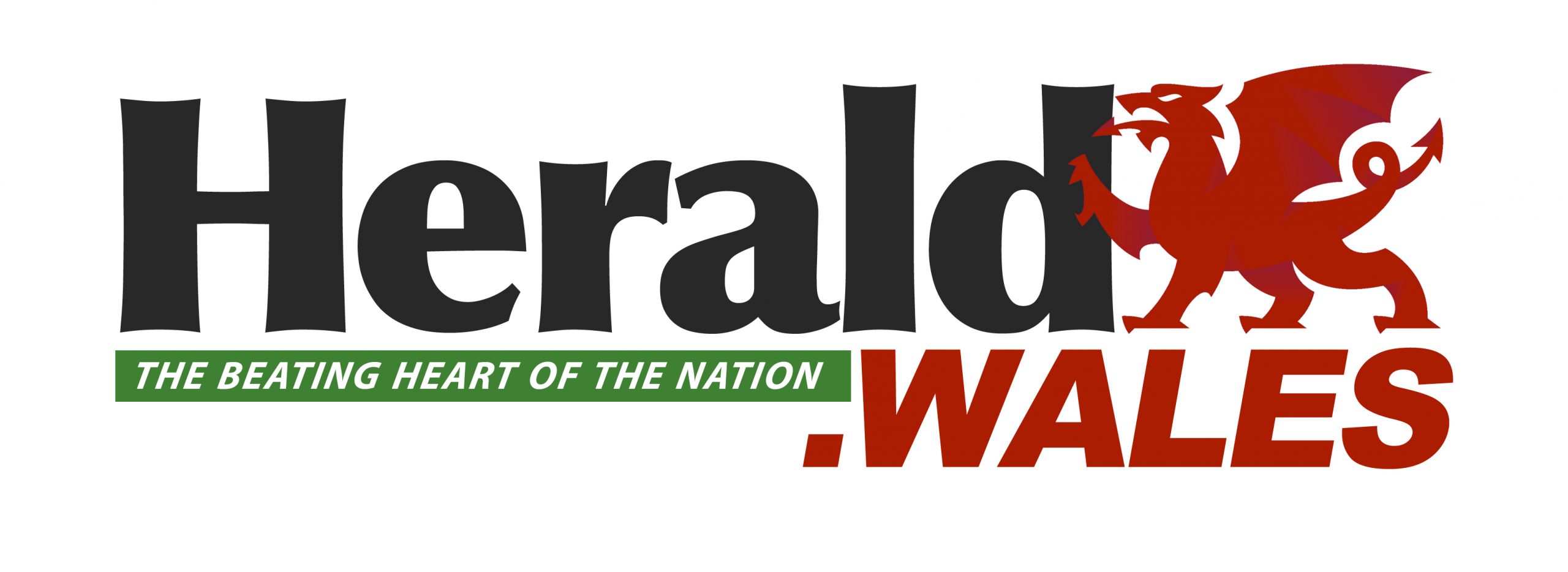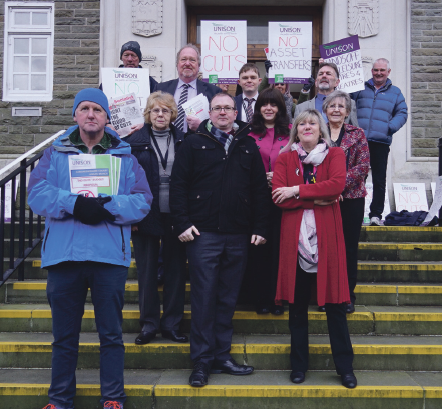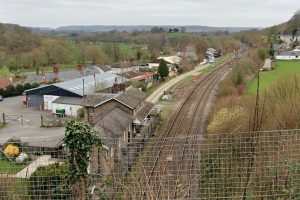
WEDNESDAY (Jan 13) and UNISON were protesting at potential job losses resulting from possible sell-offs and cuts to council services.
Union members were joined by members of the football fraternity who were there to ask questions of councillors regarding the asset transfer programme. Labour’s AM candidate Marc Tierney was at the protest and said: “I am here to show support with union members and the community of Carmarthenshire. It is important that people have their opportunity to have their say about how the budget cuts affect them. One of the concerns I had was with the consultation document itself. It did not spell out what some of these cuts particularly the cuts in education would mean for schools.”
Mr Tierney continued: “The austerity agenda is driven by the Conservatives in Westminster. That is where the funding cuts are coming from. The blame lies there. What I don’t want to see is local authorities like Carmarthenshire becoming the sub- contractor of the cuts on behalf of the Conservative Government in Westminster.” UNISON branch secretary Mark Evans told The Herald: “We are fighting all cuts, especially cuts to adult education, against any increased charges for sports pitches, and to asset transfers. We produced a no cuts budget which if this council implemented there would be no cuts for three years. We are told it is not practical yet Plaid can find £20m for a velodrome and other projects and they say it is creating jobs. Why are they creating jobs with one hand and sacking people on the other by cutting services? That is why we are here today. Their consultation talks about savings when it is not, it is cuts. It is going into the bottomless pit of cuts. They are conning the public.”
As cold as the weather was outside, it soon warmed up inside the Chamber. First to question Executive Board member in charge of the Council’s coffers, Dai Jenkins, was Mike Bassett of Carmarthenshire Unified Sports Committee (CUSC). His question turned on the supposed disproportionate numbers of cuts to facilities and increased charges affecting the south of Carmarthenshire: “Shouldn’t the Llanelli area, which contributes 43% of the County’s Council tax be entitled to its parks, playgrounds and playing fields which contribute so much to the health and wellbeing of its residents?” Dai Jenkins questioned his figures and pointed out that it was Llanelli town residents only paid 12% of the council tax and Llanelli rural residents 11% of council tax. After a long and detailed answer Mr Bassett began to ask a supplementary question and there began a spat between Mr Bassett and Peter Hughes Griffiths.
Mr Bassett said he was trying to give some context to his question about the council giving £2m to a Carmarthen museum whereas they had not given Parc Howard any money. But Chair Peter Hughes Griffiths was having none of it. He ordered Mr Bassett to sit down telling him that what he was asking was not relevant to the reply he had received from Dai Jenkins. It was then the turn of Kevin Francis also of CUSC who asked: “If town/rural/community councils are unable to take on an area listed for asset transfer, do the county council have a shortlist of third parties interested in taking over these assets, bearing in mind that CCC were unable to run them at a profit? If so could you please name them?” Dai Jenkins said that there were no third parties shortlisted and that others should step forward.

Nobody could argue that Cllr Jenkins did not have mastery of the facts and figures he deployed. The difficulty he had was that his answers simply did not satisfy the questioners’ deeper concerns. It was re-assurance they were after, plain and unadorned, not a detailed exposition of the deeper financial issues. While it is worth reflecting on the truth of the matter, that the policy on asset transfers was set in motion long before Plaid Cymru took power at County Hall, some of the attitudes struck in response to public questions did not increase confidence that some members have not been house-trained by the Independents and officer-clique. Further questions merely served as the entrée to a spectacularly bad-tempered exchange between the Chair and Wayne Erasmus, Chair of Hendy Community and Park Committee.

He asked: “When Councillor Emlyn Dole stepped in to help in the fight against the unaffordable pitch fees, he stated that these fees would put an end to participation in sport across the county. He claimed that these proposals were ill conceived and ill thought out. He was of the opinion that it was a rushed through policy developed in the midst of the twilight zone. In light of Councillor David Jenkins’ comment to the press that we simply cannot afford to maintain these areas, would he not agree that the closure of the parks in which these sports pitches are situated should demand the same response?” In a heated exchange Council Chair Peter Hughes Griffiths warned Mr. Erasmus that he must stick to the rules or he would suspend the meeting. Mr. Erasmus argued that the background to his questions were relevant but was told to ‘stop ambling’ and ask his question. It led to Councillor Anthony Jones calling a point of order and pointing out to the Chair that the public were gracious enough to attend and that he may have been a bit over zealous in his dealings with them.
At this point, Chief Executive Mark James contrived to pour petrol and drop a match on troubled waters by advising the Chair – unbidden it appeared – that he also had the power to refuse any questions. Cllr Bill Thomas also called a Point of Order to say that the Chair, and executive, were not acting according to the Nolan Principles of public life and was breaching the code of conduct. Peter Hughes Griffiths asked Cllr Thomas which of the principles he was breaching, but as Cllr Thomas tried to respond, the sound was cut from the webcast. More worryingly, the Chair said that members of the public could not simply attend meetings and make statements about the council, “we cannot have people coming into this council, standing up and saying whatever they like about it.”
As deathless phrases in the history of Carmarthenshire democracy go, that takes some beating. Eventually the Chair suspended the meeting saying, “There is a member of the public here who doesn’t behave and follow my guidance. Would you please leave?” Mr. Erasmus left, but not before accusing the council of hypocrisy. It was a troubling exchange which reflected poorly on both parties concerned. There was certainly an element of grandstanding from Mr Erasmus, but the intransigence and combativeness of the Chair did little to adorn his post’s repute. In addition, the meeting left the lingering feeling that there remains more than an element of ‘us and them’: Llanelli –v- Carmarthen; Ammanford against everybody; Councillors –v- Public; Expectations –v- Reality. There are certainly bridges to be built if the Council is going to persuade community groups and sports clubs to go with them on the next step of the asset transfer journey.













Add Comment